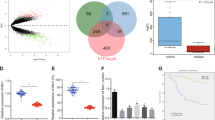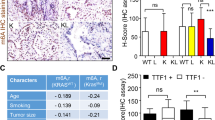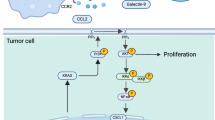Abstract
Liver kinase B1 (LKB1) loss in lung adenocarcinoma is commonly caused by genetic mutations, but these mutations rarely occur in Asian patients. We recently reported wild-type LKB1 loss via the alteration of NKX2-1/p53-axis-promoted tumor aggressiveness and predicted poor outcomes in cases of lung adenocarcinoma. The mechanistic action of wild-type LKB1 loss within tumor progression remains unknown. The suppression of MYC by LKB1 controls epithelial organization; therefore, we hypothesize that MYC expression can be increased via wild-type LKB1 loss and promotes tumor progression. Here, MYC transcription is upregulated by LKB1-loss-mediated MZF1 expression. The wild-type LKB1-loss-mediated MZF1/MYC axis is responsible for soft-agar growth, migration and invasion in lung adenocarcinoma cells. Moreover, wild-type LKB1 loss-induced cell invasiveness was markedly suppressed by MYC inhibitors (10058-F4 and JQ1). Patients with low-LKB1/high-MZF1 or low-LKB1/high-MYC tumors have shorter overall survival and relapse-free-survival periods than patients with high-LKB1/low-MZF1 or high-LKB1/low-MYC tumors. In summary, MZF1-mediated MYC expression may promote tumor progression, resulting in poor outcomes in cases of lung adenocarcinoma with low-wild-type-LKB1 tumors.
This is a preview of subscription content, access via your institution
Access options
Subscribe to this journal
Receive 50 print issues and online access
$259.00 per year
only $5.18 per issue
Buy this article
- Purchase on SpringerLink
- Instant access to full article PDF
Prices may be subject to local taxes which are calculated during checkout




Similar content being viewed by others
References
Makowski L, Hayes DN . Role of LKB1 in lung cancer development. Br J Cancer 2008; 99: 683–688.
Koivunen JP, Kim J, Lee J, Rogers AM, Park JO, Zhao X et al. Mutations in the LKB1 tumour suppressor are frequently detected in tumours from Caucasian but not Asian lung cancer patients. Br J Cancer 2008; 99: 245–252.
Sun Y, Ren Y, Fang Z, Li C, Fang R, Gao B et al. Lung adenocarcinoma from East Asian never-smokers is a disease largely defined by targetable oncogenic mutant kinases. J Clin Oncol 2010; 28: 4616–4620.
Onozato R, Kosaka T, Achiwa H, Kuwano H, Takahashi T, Yatabe Y et al. LKB1 gene mutations in Japanese lung cancer patients. Cancer Sci 2007; 98: 1747–1751.
Kim MJ, Jin G, Jheon HS, Lee SY, Cha SI, Kim CH et al. LKB1 mutations are extremely rare in Korean non-small cell lung cancers. Cancer Genet Cytogenet 2010; 196: 204–206.
Tsai LH, Chen PM, Cheng YW, Chen CY, Sheu GT, Wu TC et al. LKB1 loss by alteration of the NKX2-1/p53 pathway promotes tumor malignancy and predicts poor survival and relapse in lung adenocarcinomas. Oncogene (e-pub ahead of print 2 September 2013; doi:10.1038/onc.2013.353).
Scott KD, Nath-Sain S, Agnew MD, Marignani PA . LKB1 catalytically deficient mutants enhance cyclin D1 expression. Cancer Res 2007; 67: 5622–5627.
Feng Y, Wang Y, Wang Z, Fang Z, Li F, Gao Y et al. The CRTC1-NEDD9 signaling axis mediates lung cancer progression caused by LKB1 loss. Cancer Res 2012; 72: 6502–6511.
Gao Y, Xiao Q, Ma H, Li L, Liu J, Feng Y et al. LKB1 inhibits lung cancer progression through lysyl oxidase and extracellular matrix remodeling. Proc Natl Acad Sci USA 2010; 107: 18892–18897.
Ji H, Ramsey MR, Hayes DN, Fan C, McNamara K, Kozlowski P et al. LKB1 modulates lung cancer differentiation and metastasis. Nature 2007; 448: 807–810.
Partanen JI, Nieminen AI, Makela TP, Klefstrom J . Suppression of oncogenic properties of c-Myc by LKB1-controlled epithelial organization. Proc Natl Acad Sci USA 2007; 104: 14694–14699.
Partanen JI, Tervonen TA, Myllynen M, Lind E, Imai M, Katajisto P et al. Tumor suppressor function of Liver kinase B1 (Lkb1) is linked to regulation of epithelial integrity. Proc Natl Acad Sci USA 2012; 109: E388–E397.
Hromas R, Morris J, Cornetta K, Berebitsky D, Davidson A, Sha M et al. Aberrant expression of the myeloid zinc finger gene, MZF-1, is oncogenic. Cancer Res 1995; 55: 3610–3614.
Hromas R, Collins SJ, Hickstein D, Raskind W, Deaven LL, O'Hara P et al. A retinoic acid-responsive human zinc finger gene, MZF-1, preferentially expressed in myeloid cells. J Biol Chem 1991; 266: 14183–14187.
Messeguer X, Escudero R, Farre D, Nunez O, Martinez J, Alba MM . PROMO: detection of known transcription regulatory elements using species-tailored searches. Bioinformatics 2002; 18: 333–334.
Farre D, Roset R, Huerta M, Adsuara JE, Rosello L, Alba MM et al. Identification of patterns in biological sequences at the ALGGEN server: PROMO and MALGEN. Nucleic Acids Res 2003; 31: 3651–3653.
Delmore JE, Issa GC, Lemieux ME, Rahl PB, Shi J, Jacobs HM et al. BET bromodomain inhibition as a therapeutic strategy to target c-Myc. Cell 2011; 146: 904–917.
Huang MJ, Cheng YC, Liu CR, Lin S, Liu HE . A small-molecule c-Myc inhibitor, 10058-F4, induces cell-cycle arrest, apoptosis, and myeloid differentiation of human acute myeloid leukemia. Exp Hematol 2006; 34: 1480–1489.
Wang H, Hammoudeh DI, Follis AV, Reese BE, Lazo JS, Metallo SJ et al. Improved low molecular weight Myc-Max inhibitors. Mol Cancer Ther 2007; 6: 2399–2408.
Gu Y, Lin S, Li JL, Nakagawa H, Chen Z, Jin B et al. Altered LKB1/CREB-regulated transcription co-activator (CRTC) signaling axis promotes esophageal cancer cell migration and invasion. Oncogene 2012; 31: 469–479.
Payne SL, Hendrix MJ, Kirschmann DA . Paradoxical roles for lysyl oxidases in cancer—a prospect. J Cell Biochem 2007; 101: 1338–1354.
Mudduluru G, Vajkoczy P, Allgayer H . Myeloid zinc finger 1 induces migration, invasion, and in vivo metastasis through Axl gene expression in solid cancer. Mol Cancer Res 2010; 8: 159–169.
Miyaki M, Iijima T, Hosono K, Ishii R, Yasuno M, Mori T et al. Somatic mutations of LKB1 and beta-catenin genes in gastrointestinal polyps from patients with Peutz–Jeghers syndrome. Cancer Res 2000; 60: 6311–6313.
Ossipova O, Bardeesy N, DePinho RA, Green JB . LKB1 (XEEK1) regulates Wnt signalling in vertebrate development. Nat Cell Biol 2003; 5: 889–894.
Liu H, Radisky DC, Yang D, Xu R, Radisky ES, Bissell MJ et al. MYC suppresses cancer metastasis by direct transcriptional silencing of alphav and beta3 integrin subunits. Nat Cell Biol 2012; 14: 567–574.
Ma L, Young J, Prabhala H, Pan E, Mestdagh P, Muth D et al. miR-9, a MYC/MYCN-activated microRNA, regulates E-cadherin and cancer metastasis. Nat Cell Biol 2010; 12: 247–256.
Wolfer A, Wittner BS, Irimia D, Flavin RJ, Lupien M, Gunawardane RN et al. MYC regulation of a ‘poor-prognosis’ metastatic cancer cell state. Proc Natl Acad Sci USA 2010; 107: 3698–3703.
Cho KB, Cho MK, Lee WY, Kang KW . Overexpression of c-myc induces epithelial mesenchymal transition in mammary epithelial cells. Cancer Lett 2010; 293: 230–239.
Ischenko I, Zhi J, Moll UM, Nemajerova A, Petrenko O . Direct reprogramming by oncogenic Ras and Myc. Proc Natl Acad Sci USA 2013; 110: 3937–3942.
Fernandez P, Carretero J, Medina PP, Jimenez AI, Rodriguez-Perales S, Paz MF et al. Distinctive gene expression of human lung adenocarcinomas carrying LKB1 mutations. Oncogene 2004; 23: 5084–5091.
Sanchez-Cespedes M, Parrella P, Esteller M, Nomoto S, Trink B, Engles JM et al. Inactivation of LKB1/STK11 is a common event in adenocarcinomas of the lung. Cancer Res 2002; 62: 3659–3662.
Shimamura T, Chen Z, Soucheray M, Carretero J, Kikuchi E, Tchaicha JH et al. Efficacy of BET bromodomain inhibition in Kras-mutant non-small cell lung cancer. Clin Cancer Res 2013; 19: 6183–6192.
Cheng YW, Wu MF, Wang J, Yeh KT, Goan YG, Chiou HL et al. Human papillomavirus 16/18 E6 oncoprotein is expressed in lung cancer and related with p53 inactivation. Cancer Res 2007; 67: 10686–10693.
Sung WW, Wang YC, Cheng YW, Lee MC, Yeh KT, Wang L et al. A polymorphic -844T/C in FasL promoter predicts survival and relapse in non-small cell lung cancer. Clin Cancer Res 2011; 17: 5991–5999.
Wu DW, Liu WS, Wang J, Chen CY, Cheng YW, Lee H . Reduced p21(WAF1/CIP1) via alteration of p53-DDX3 pathway is associated with poor relapse-free survival in early-stage human papillomavirus-associated lung cancer. Clin Cancer Res 2011; 17: 1895–1905.
Wu HH, Cheng YW, Chang JT, Wu TC, Liu WS, Chen CY et al. Subcellular localization of apurinic endonuclease 1 promotes lung tumor aggressiveness via NF-kappaB activation. Oncogene 2010; 29: 4330–4340.
Steger DJ, Lefterova MI, Ying L, Stonestrom AJ, Schupp M, Zhuo D et al. DOT1L/KMT4 recruitment and H3K79 methylation are ubiquitously coupled with gene transcription in mammalian cells. Mol Cell Biol 2008; 28: 2825–2839.
Gong F, Sun L, Wang Z, Shi J, Li W, Wang S et al. The BCL2 gene is regulated by a special AT-rich sequence binding protein 1-mediated long range chromosomal interaction between the promoter and the distal element located within the 3'-UTR. Nucleic Acids Res 2011; 39: 4640–4652.
Wu DW, Cheng YW, Wang J, Chen CY, Lee H . Paxillin predicts survival and relapse in non-small cell lung cancer by microRNA-218 targeting. Cancer Res 2010; 70: 10392–10401.
Acknowledgements
This work was jointly supported by grants from the National Science Council (NSC1-100-2314-B-038-043-MY3) of Taiwan, ROC.
Author information
Authors and Affiliations
Corresponding author
Ethics declarations
Competing interests
The authors declare no conflict of interest.
Additional information
Supplementary Information accompanies this paper on the Oncogene website
Supplementary information
Rights and permissions
About this article
Cite this article
Tsai, LH., Wu, JY., Cheng, YW. et al. The MZF1/c-MYC axis mediates lung adenocarcinoma progression caused by wild-type lkb1 loss. Oncogene 34, 1641–1649 (2015). https://doi.org/10.1038/onc.2014.118
Received:
Revised:
Accepted:
Published:
Issue date:
DOI: https://doi.org/10.1038/onc.2014.118
This article is cited by
-
Ubiquitination and deubiquitination in the regulation of N6-methyladenosine functional molecules
Journal of Molecular Medicine (2024)
-
SETD8 cooperates with MZF1 to participate in hyperglycemia-induced endothelial inflammation via elevation of WNT5A levels in diabetic nephropathy
Cellular & Molecular Biology Letters (2022)
-
MZF1 mediates oncogene-induced senescence by promoting the transcription of p16INK4A
Oncogene (2022)
-
Release of transcriptional repression via ErbB2-induced, SUMO-directed phosphorylation of myeloid zinc finger-1 serine 27 activates lysosome redistribution and invasion
Oncogene (2019)
-
Molecular and Transcriptional Signatures for ErbB2-Induced Invasion
Current Pharmacology Reports (2019)



